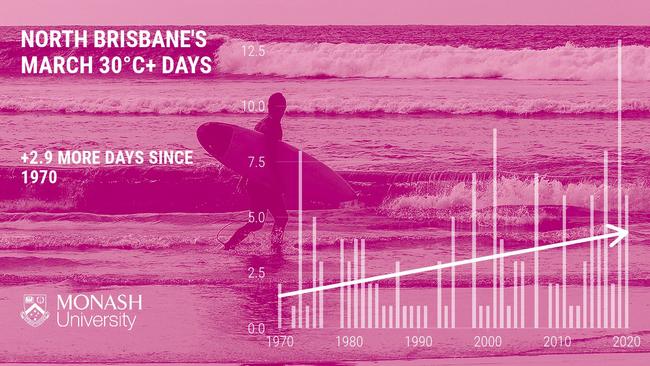Autumn is here, but summer temperatures are sticking around for longer in north Brisbane
Dr Christa Pudmenzky discusses north Brisbane's March climate. Plus, research shows summer temperatures could extend into March.

HyperLocal
Don't miss out on the headlines from HyperLocal. Followed categories will be added to My News.
Autumn brings cooler temperatures to southeast Queensland, but March wasn't always this warm.
Over the past 50 years, the number of March days reaching at least 30 degrees has increased.
In 1970, north Brisbane typically only had one day each March when temperatures climbed to 30 degrees.
Now, it's more like four such days.
Voices from your community
Mango Hill resident Christie Hay was very concerned about the shifts in temperature.
"It's very clear that local temperatures have significantly increased over time," she said.
"Failing to recognise this simple fact is highly detrimental to our society.
"It's clear that over the years farmers have had to face immense struggle due to multiple reasons.
"However the climate has certainly made a huge impact for them in a negative way."
Community voices like Christie's tell us how residents and business owners in North Brisbane feel about their local climate. If you would like to contribute your voice to our column, you can fill out our 5-minute survey here.
Fast fact
Research from The Australia Institute, a Canberra-based think tank, found that Brisbane summers are around two weeks longer than they were in the mid-20th century.
This means temperatures that residents typically associate with summer are now occurring well into March.
All capital cities across Australia are experiencing longer summers and shorter winters, compared to a few decades ago.
These warming trends are linked to an increase in greenhouse gas emissions from human activities, such as burning fossil fuels.
Want more information on how your climate is changing? Check out last week's article here.
Dr Christa Pudmenzky is a climate scientist at the University of Southern Queensland.
This column is part of a collaboration between the Monash Climate Change Communication Research Hub and News Corp to deliver hyperlocal weather and climate information.
Follow the Hub on Twitter to join the conversation.


